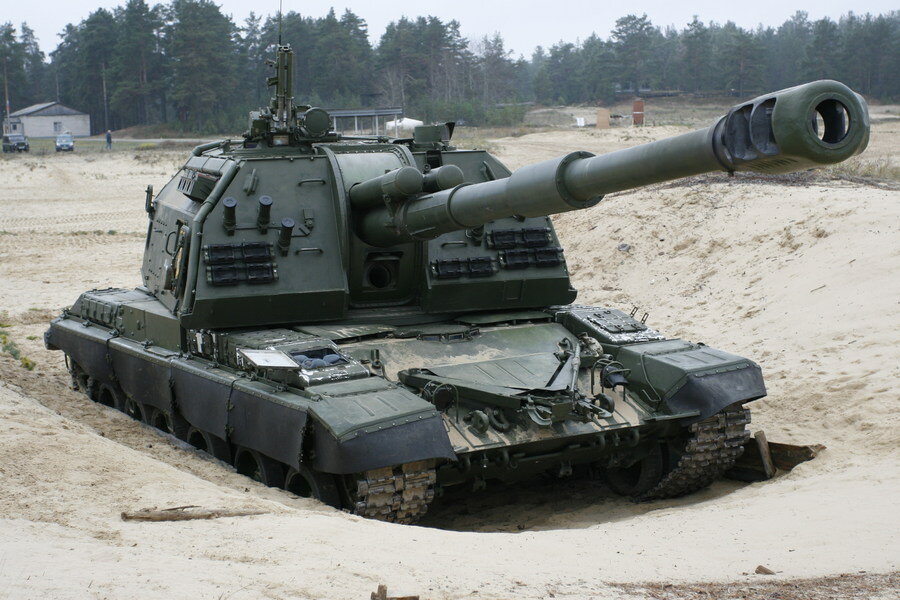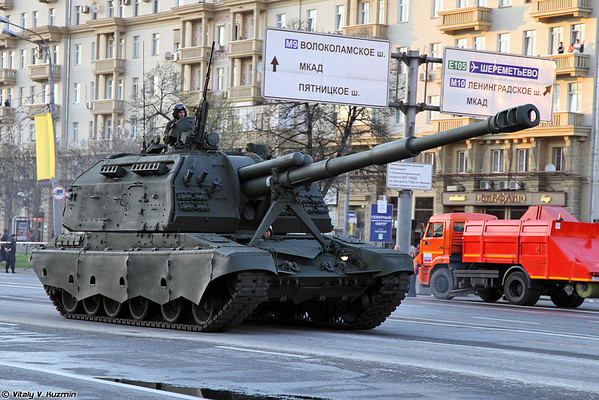 GarryB Mon Dec 19, 2011 11:12 pm
GarryB Mon Dec 19, 2011 11:12 pm
Yes, I believe that top photo is the new gun... the recoil mechanism seems to be moved from above the barrel to below the barrel, and above the barrel is what appears to be a muzzle reference system... a small radar that transmits a very weak signal down the gun barrel. There is normally a reflector on the end of the barrel so the radar can detect even small deflections in the barrel. Often if the vehicle is sitting out in the sun the top half of the barrel is heated by direct sunlight while the underneath of the barrel remains cooler so the top half expands and the bottom half does not... this distorts the barrel shape, which the muzzle reference system can detect and alter the ballistic calculations to allow for in working out where the shells will land. After a few shots are fired the whole barrel is heated so the system continuously monitors the barrel for changes in droop or shape. If, driving through a forest, the barrel hits a tree and is bend slightly, the muzzle reference system will alert the crew and try to determine the effect on accuracy and trajectory.
Even with guided shells you can't just point the gun in any direction and fire and expect the shell to get near the target... the gun still needs to be aimed, but with guided shells the extreme precision needed for unguided shells is not needed.
It clearly has an extended length barrel, with a standard muzzle brake. This is perhaps a single barrel variant of the previously seen Coalition with dual feed auto loading and rather substantial muzzle brakes developed together with the Russian Navy. Of course the Coalition was based on the T-95 chassis rather than the T-80 as seen in these two photos... the Coalition turret is huge and also unmanned. The three man crew sat in the front hull position where the crew sit in the T-95. (The T-95 as an unmanned turret too, though not as big as the one on Coalition as it mounted two 152mm guns one on top of the other, with side mounted belt feeds on either side of both weapons leading to two autoloaders.
Both these photos clearly show manned turrets on T-80 chassis.
An advantage of a single (longer) gun in a manned turret is that upgraded T-72 chassis can be used till Armata is ready (it is also a tank with an unmanned turret).
In Armata brigades Coalition would work well, while in brigades equipped with upgraded T-72s then a change from the T-80 base vehicle to a T-72 or T-90 chassis would make logistical sense.
I seem to remember them saying it would extend the range of standard ammo to about 40km and that extended range new ammo would go further (as would extended range current ammo one presumes).
With the new fuses/guidance packages accuracy will be excellent.
Obviously $1,000 US sounds like a lot of money, but an RPG-7 rocket would probably cost about $700-800 US dollars or more, so a 152mm artillery shell would likely cost a couple of thousand dollars with a normal mechanical fuse costing several hundred dollars... especially with multiple safeties and a proximity fuse, so $1,000 US for an electronic fuse with GLONASS guidance is actually very cheap... especially when it reduces the number of shells needed per target will dramatically be reduced.
In many ways it is similar to Ugroza in that although more expensive per round, you save a lot of money because not only are you needing a small fraction of the shots needed to deal with targets, you can also engage targets from extended ranges and still be confident of a kill, and you spend less time firing at targets, both of which make the firing platform much safer and more efficient on the battlefield.
Against area targets cheaper unguided munitions can still be used where appropriate.










